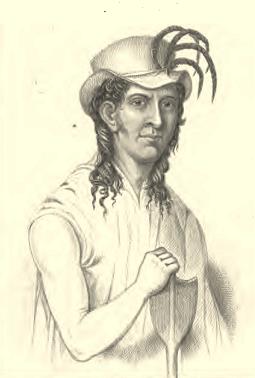Revised Jun 21 2021
⇐ Chronometer Home TITPTP Briton and Tagus ⇒
The Island, the People, and the Pastor
Ch. V - Staines Letter
LETTER FROM SIR T. STAINES.
No further notice was taken of Pitcairn's island, nor of its inhabitants, until 1814, when his Majesty's ships Briton and Tagus, Captain Sir Thomas Staines, and Captain Pipon, being in search of an American ship of war, the Essex, which had been seizing some of our whaling vessels, arrived at the spot. Adams, upon this, supposed that his time was come, and that he should be carried away. Although much alarmed, he did not attempt concealment, but presented himself to the officers, who soon reassured him, by saying that he was not to be arrested; the time was past for that; he had been a quarter of a century on the island, and his presence was useful to the islanders.
The condition of the place and people at that date cannot be better described than by Sir T. Staines, in his own words, in a letter addressed by him to Vice-Admiral Manley Dixon:—
"Briton, Valparaiso, Oct. 18, 1814.
"SIR,—I have the honour to inform you that on my passage from the Marquesas Islands to this point, on the morning of the 17th September, I fell in with an island where none is laid down in the Admiralty or other charts, according to the several chronometers of the Briton and Tagus. I therefore hove-to until daylight, and then closed, to ascertain whether it was inhabited, which I soon discovered it to be, and, to my great astonishment, found that every individual on the island (forty in number) spoke very good English. They proved to be the descendants of the deluded crew of the Bounty, which from Otaheite proceeded to the above-mentioned island, where the ship was burnt.
"Christian appeared to have been the leader, and the sole cause of the mutiny in that ship. A venerable old man, named John Adams, is the only surviving Englishman of those who last quitted Otaheite in her, and whose exemplary conduct, and fatherly care of the whole little colony, could not but command admiration. The pious manner in which all those born on the island have been reared, the correct sense of religion which has been instilled into their young minds by this old man, has given him the pre-eminence over the whole of them, to whom they look up as the father of the whole, and one family.
"A son of Christian was the first born on the island, now about twenty-five years of age (named Thursday October Christian); the elder Christian fell a sacrifice to the jealousy of an Otaheitan man, within three or four years after their arrival on the island. They were accompanied thither by six Otaheitan men and twelve women; the former were all swept away by desperate contentions between them and the Englishmen, and five of the latter have died at different periods, leaving at present only one man and several women of the original settlers.
"The island must, undoubtedly, be that called Pitcairn, although erroneously laid down in the charts. We had the meridian sun close to it, which gave us 25 deg. 4 min. S. latitude, and 130 deg. 25 min. W. longitude, by chronometers of the Briton and Tagus. It is abundant in yams, plantains, hogs, goats, and fowls, but affords no shelter for a ship or vessel of any description; neither could a ship water there without great difficulty.
"I cannot refrain from offering my opinion that it is well worthy the attention of our laudable religious Societies, particularly that for propagating the Christian religion, the whole of the inhabitants speaking the Otaheitan tongue as well as English. During the whole of the time they have been on the island, only one ship has ever communicated with them, which took place about six years since, by an American ship, called the Topaz, of Boston, Mayhew Folger, master. The island is completely iron-bound, with rocky shores, and landing in boats at all times difficult, although safe to approach within a short distance in a ship.
It is remarkable, that in this letter John Adams should have been styled a "venerable old man." He was then only fifty years of age. But he had suffered much anxiety. For a long period of his life he had been a stranger to security; and his weather-beaten face bore marks of a more advanced age than that which he had attained. He is mentioned in Bligh's description, as very much pitted with the smallpox, and tattooed on his body, legs, arms, and feet.

Thursday October Christian